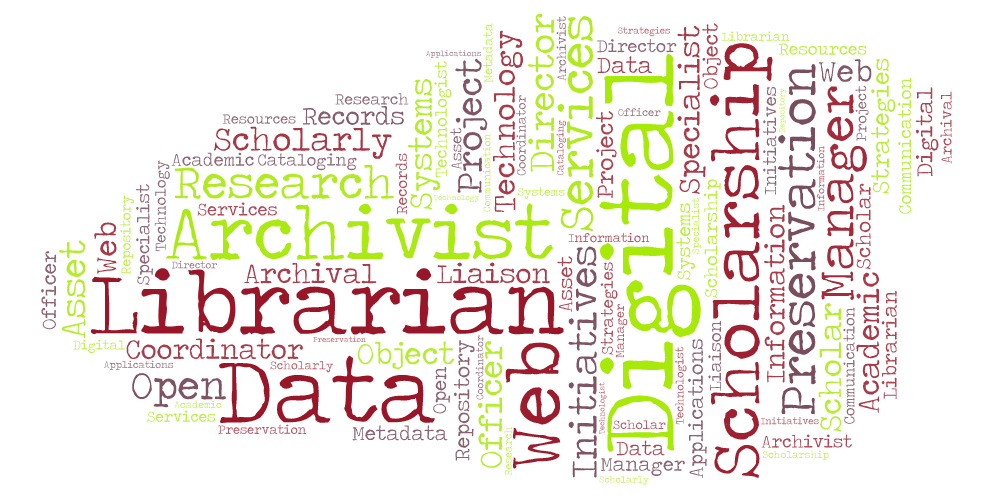On January 7th I delivered a “lightning talk” presentation at the 2022 New Jersey Academic Libraries Conference, Rethinking Digital Initiatives: Challenges and Opportunities. My topic was a recent research project, submitted for publication this fall, on the practice of digital initiatives—something I’ve been engaged in professionally for the past decade in three different academic library environments.
Throughout my career I observed the title Digital Initiatives defined inconsistently. Where definitions appear consistent, postings from several employment-oriented electronic mailing lists suggest responsibilities typically associated with the position often fall under a range of similar but divergent titles. In many organizations digital initiatives are combined with other, potentially unrelated positions, introducing additional inconsistencies. Both my current (Digital Initiatives and Special Collections) and previous (Web and Digital Services) position titles provide examples of this phenomenon.
I began to wonder if my personal interpretation of the role, above and beyond any formal description, had a factual or historical basis. At the same time, I found myself evaluating my education in library science and how effectively it prepared me for the practice. From these questions I arrived at the following thesis:
Digital Initiatives are increasingly represented in contemporary librarianship, but inconsistent definitions, standards, and expectations limit the effectiveness of practitioners.
Position descriptions and titles in academic libraries are subject to periodic analysis, revealing emerging professional trends. Some researchers conjecture that heterogeneity indicates a lack of sufficient technical understanding on the part of administrators. Others suggest any imprecision or ambiguity reflects “hedging” in the face of uncertainty and rapid technological change. Coming to the profession from a background in literature studies (with a corresponding affinity for traditional texts), many librarians demonstrate affinity bias when evaluating requirements and developing new titles. Successful candidates may find themselves unfamiliar with the technologies supporting digital projects.
A literature review, job title survey, and examination of publicly accessible web content suggests that the proliferation of similar, related, and intersecting requirements, skills, and professional responsibilities is ongoing. Staffing and organizational structures supporting the work display similar variability. Based on my investigation, I offered the following recommendations:
- Include technologists and technology practitioners, both within and outside of the library, as participants in needs analysis, curriculum development, and position definition.
- Adopt standards for structuring library organizational units (staffing, administration, technology and financial support) along with standards for position titles and educational requirements.
- Develop curricula that include broad but sufficiently detailed exposure to systems, software development, project management, and related disciplines.
These innovations may not be adopted until the academy demands greater consistency from the library, not unlike how advances in online search, publishing, and digital research materials influenced the evolution of catalogs and discovery services. But with contemporary universities fundamentally composed of diverse—and occasionally conflicting—organizational cultures, the path toward a standardized academic digital initiatives practice is unclear.
Contemplating my career I find myself asking a related, personal question: How did I end up involved in academic library digital initiatives?
Upon graduating secondary school I was expected to pursue a college degree, and, having spent a lot of time in and around Richmond, I was very interested in applying to Virginia Commonwealth University. Created through the 1968 merger of the Medical College of Virginia with the Richmond Professional Institute, VCU inherited RPI’s highly regarded School of Art, which had since evolved into the third largest arts college in the United States. I had no talent for sculpture or painting, but was drawn to their Communication Arts & Design BFA program. Looking back, it seems I was always interested in how presentation and structure can enhance the transmission, comprehension, and retention of information.
Unfortunately my parents disapproved of the institution, perhaps due to its poorly regarded association with vocational studies, or possibly its location in a marginally urban environment. As I was not prepared to support my education at the time I acquiesced to their wishes, attending a more prestigious school that offered little I found academically engaging. A decade later I revisited my undergraduate studies, and my previous interests, since forgotten, manifested themselves once again—this time in the form of information science. And now I find myself once again thinking about design.
Historically, library technology centers around information discovery. Personal experience leads me to believe that library professionals can contribute toward the acquisition of knowledge beyond curating and collecting materials. Instruction is one approach, but I contend that, as our dependence upon them increases, improving the technologies supporting pedagogy will become invaluable. So I find myself almost accidentally arriving at a destination I initially envisioned.
